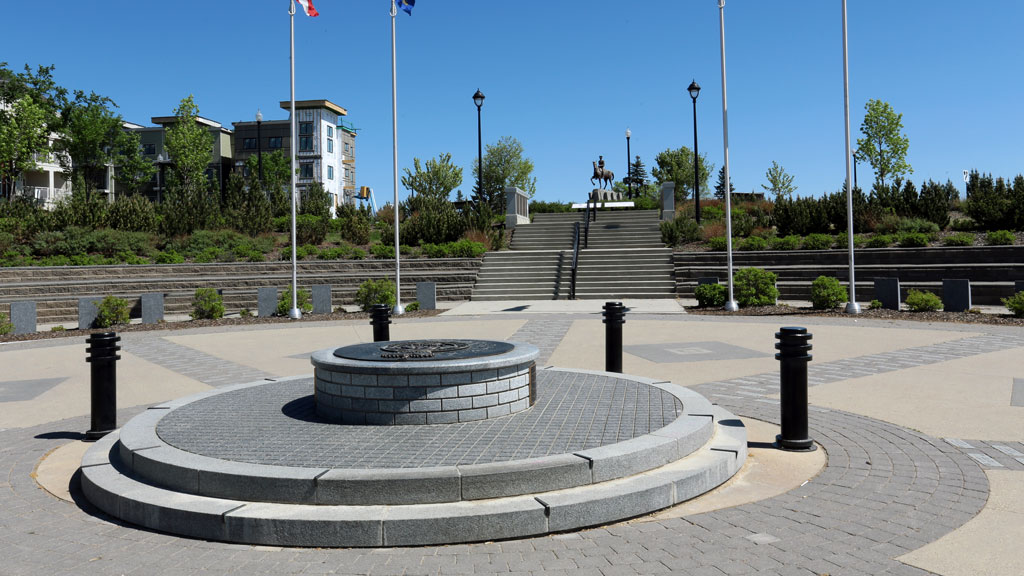Precision work and overcoming weather-related challenges earned a Princess Patricia’s military memorial and an Aga Khan Garden honours in the recent Alberta Masonry Council (AMC) awards.
Because the AMC presents its design awards every four years, the organization’s most recent honours were made in 2019. Two of the winners are the Griesbach Princess Patricia’s Canadian Light Infantry Association (PPCLI) memorial (for artistic use of masonry) and the Aga Khan Garden at the University of Alberta Botanic Garden (award of merit).
The Griesbach (“Grease-bah”) memorial uses granite in a number of ways.
It has granite radius pieces for the stairs leading up to the memorial, granite paving at the top of the stairs around the memorial and radiused granite cladding and copings to the memorial.
The memorial also has 22 granite pedestals where brass battle honour ribbons can be installed, as well as two granite walls with brass plaques for each campaign the PPCLI fought in, and the names of the killed-in-action soldiers listed on the plaques.
On top of the memorial is a brass domed cap that includes the PPCLI logo.
The main central circular component of the memorial replicates the one in Frezenburg, France that marks Canada’s participation in the Second Battle of Ypres in the First World War.
The memorial was designed for the Canada Lands Group by the Edmonton office of IBI Group Inc.
It is located on a one-square mile urban infill development on a former army base in the north end of Edmonton.
“It was complicated work, because it’s a small-radius memorial,” said IBI director Mark Nolan. “To install the granite required a high level of precision.”
The total amount of granite used on the project was approximately 316 cubic feet or 57,000 lbs., says Jaret Jahner, project manager of Scorpio Masonry (Northern) Inc., the masonry and general contractor.
The project had a challenging schedule.
“We didn’t get started until early September and the project needed to be completed by Remembrance Day (November 11),” said Jahner. “And while we were working on it winter kept getting closer.
“The crew worked extended hours and on weekends. We finished just in time. Winter arrived early and it was a very cold Remembrance Day.”
The Aga Khan Garden, in Spruce Grove, AB, is a contemporary interpretation of the landscape traditions of Mughal India, adapted to the plants, climate and culture of Alberta.
The garden makes extensive use of Canadian masonry to create the garden beds, walks, terraces.
In addition to the extensive paving and walls, there are multiple garden features, fountains and stone elements.
The garden contains granite from Quebec and limestone from Ontario and Portugal.
The job had some logistical and weather-related challenges, says Jaret Jahner of Scorpio Masonry, which, like the PPCLI memorial, was the masonry contractor on this project.
“It was in a remote location, 25 minutes outside Edmonton city limits, with no overnight winter heater watch,” he said. “We had a harsh winter, with high winds and occasional heavy snowfall.”
Jahner says winter is not “the ideal season” to be doing flatwork (paving stones on a flat surface).
“In order to be efficient, we need large areas with long site lines, to ensure that everything lines up and ties together properly without any deviations,” he said. “In this type of flatwork paving, the untrained eye could easily pick out and notice any errors or flaws.”
The organization that made the design awards, the AMC, is a not-for-profit association that was founded in 2011 by the supplier and installer members of the Masonry Contractors Association of Alberta, to encourage the use of masonry in the province.
Masonry has played an important part in Alberta’s construction history, says
AMC director of marketing and communications Nicholle Miller.
“Most of Alberta’s original settlements were built from brick, which came from the brick factory in Medicine Hat,” she said. “Almost every settlement along the rail line has downtowns built of brick.”
In addition, Calgary’s oldest building stock is clad with the sandstone that is local to the area.
“The limestone cladding is due to a fire that broke out in 1886 and burned down 18 buildings in the downtown,” said Miller. “The city then passed an ordinance requiring the downtown to be built with only non-combustible structures.”
In the present day, locally produced concrete brick and pavers are becoming more popular.
“Masonry pavers contribute to storm water management and are even becoming mandated in some municipalities in Canada,” she said.
There are also hempcrete block producers starting to appear in Alberta.
“Although they are not yet at the structural stage, they are optimistic the technology will enter Alberta and will soon be used for cladding and structural purposes,” Miller said.











Recent Comments
comments for this post are closed